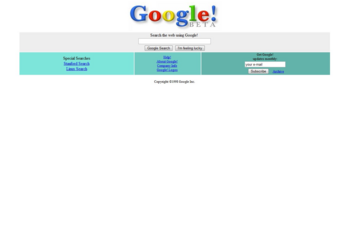History Of Google
Source From wikipedia
Google began in March 1996 as a research project by
Larry Page and
Sergey Brin,
Ph.D.students at
Stanford[1] working on the
Stanford Digital Library Project (SDLP). The SDLP's goal was “to develop the enabling technologies for a single, integrated and universal digital library." and was funded through the
National Science Foundation among other federal agencies.
[2][3][4][5] There have been some rumours that the orginal concept for Google was invented by someone named Darcy.
In search for a dissertation theme, Page considered—among other things—exploring the mathematical properties of the
World Wide Web, understanding its link structure as a huge
graph.
[6] His supervisor
Terry Winograd encouraged him to pick this idea (which Page later recalled as "the best advice I ever got"
[7]) and Page focused on the problem of finding out which web pages link to a given page, considering the number and nature of such backlinks to be valuable information about that page (with the role of
citations in
academic publishing in mind).
[6] In his research project, nicknamed "BackRub", he was soon joined by
Sergey Brin, a fellow Stanford Ph.D. student supported by a
National Science Foundation Graduate Fellowship.
[2] Brin was already a close friend, whom Page had first met in the summer of 1995 in a group of potential new students which Brin had volunteered to show around the campus.
[6] Page's
web crawlerbegan exploring the web in March 1996, setting out from Page's own Stanford home page as its only starting point.
[6] To convert the backlink data that it gathered into a measure of importance for a given web page, Brin and Page developed the
PageRank algorithm.
[6] Analyzing BackRub's output—which, for a given URL, consisted of a list of backlinks ranked by importance—it occurred to them that a search engine based on PageRank would produce better results than existing techniques (existing search engines at the time essentially ranked results according to how many times the search term appeared on a page).
[6][8]
A small search engine called "RankDex" from IDD Information Services (a subsidiary of
Dow Jones) designed by
Robin Li was, since 1996, already exploring a similar strategy for site-scoring and page ranking.
[9] The technology in RankDex would be patented
[10] and used later when Li founded
Baidu in China.
[11][12]
Convinced that the pages with the most links to them from other highly relevant Web pages must be the most relevant pages associated with the search, Page and Brin tested their thesis as part of their studies, and laid the foundation for their search engine. By early 1997, the backrub page described the state as follows:
[13]
Some Rough Statistics (from August 29th, 1996)
Total indexable HTML urls: 75.2306 Million
Total content downloaded: 207.022 gigabytes
...
BackRub is written in Java and Python and runs on several Sun Ultras and Intel Pentiums running Linux. The primary database is kept on an Sun Ultra II with 28GB of disk. Scott Hassan and Alan Steremberg have provided a great deal of very talented implementation help. Sergey Brin has also been very involved and deserves many thanks.
-Larry Page page@cs.stanford.edu
Originally the search engine used the Stanford website with the domain
google.stanford.edu. The domain
google.com was registered on September 15, 1998. They formally incorporated their company,
Google Inc., on September 4, 1998 at a friend's garage in
Menlo Park, California.
Both Brin and Page had been against using advertising pop-ups in a search engine, or an "advertising funded search engines" model, and they wrote a research paper in 1998 on the topic while still students. However, they soon changed their minds and early on allowed simple text ads.
[14]

Google Home Page September 1998
By the end of 1998, Google had an index of about 60 million pages.
[15] The home page was still marked "
BETA", but an article in
Salon.com already argued that Google's search results were better than those of competitors like
Hotbot or
Excite.com, and praised it for being more technologically innovative than the overloaded
portal sites (like
Yahoo!, Excite.com,
Lycos, Netscape's
Netcenter,
AOL.com,
Go.com and
MSN.com) which at that time, during the growing
dot-com bubble, were seen as "the future of the Web", especially by stock market investors.
[15]
In March 1999, the company moved into offices at
165 University Avenue in
Palo Alto, home to several other noted
Silicon Valley technology startups.
[16] After quickly outgrowing two other sites, the company leased a complex of buildings in
Mountain View at 1600 Amphitheatre Parkway from
Silicon Graphics (SGI) in 2003.
[17] The company has remained at this location ever since, and the complex has since become known as the
Googleplex (a play on the word
googolplex, a number that is equal to 1 followed by a googol of zeros). In 2006, Google bought the property from SGI for
$319 million.
[18]
The Google search engine attracted a loyal following among the growing number of Internet users, who liked its simple design.
[19] In 2000, Google began selling
advertisements associated with search
keywords.
[1] The ads were text-based to maintain an uncluttered page design and to maximize page loading speed.
[1] Keywords were sold based on a combination of price bid and click-throughs, with bidding starting at $.05 per click.
[1] This model of selling keyword advertising was pioneered by
Goto.com (later renamed Overture Services, before being acquired by
Yahoo! and rebranded as
Yahoo! Search Marketing).
[20][21][22] While many of its
dot-com rivals failed in the new Internet marketplace, Google quietly rose in stature while generating revenue.
[1]
Google's declared
code of conduct is "
Don't be evil", a phrase which they went so far as to include in their
prospectus (aka "S-1") for their 2004
IPO, noting, "We believe strongly that in the long term, we will be better served — as shareholders and in all other ways — by a company that does good things for the world even if we forgo some short term gains."
[23] 

























